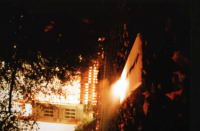Lee Cavaliere
For sales, commissions and to send comments to the artist click here
Introduction
At
the heart of my work lies the human effort, and the essence of a journey
to a location, real or imagined, in order to examine the particular importance
it holds for us.
Much of our method of perceiving landscape in general is based on how
we see ourselves, and humanity, in relation to it. I address issues of
the man in the landscape literally, by taking myself to these places and
performing various actions in order to make art works. The locations then
speak through the art created within them.
This methodology also brings up issues of the artist’s involvement
in the work, and the symbiosis of subject, action and created object.
These are photos, and the sound was recorded, by the artist, while up
a mountain - these are important issues of a discourse between the artist
and subject which are not often addressed within landscape art from a
contemporary perspective.
|
|
|
|
|
|
|
Flaming
Arrows Were Fired into Primed Canvases by the Artist, a Novice Bowman,
at Haydon Bridge, Northumbria,Home of John Martin (1789-1854) (Fire
Painting 1) (2001)
Burned canvases, 24cmx24cm In
an attempt to represent the element of fire in visual art, I took
inspiration from the 19th century sublime painter, John Martin.
In his opium - fuelled paintings of the Northumbria countryside,
terrified mortals flee in awe from the immensity of nature, personified
by God’s wrath. Fire is a common representation of this great
power in Martin’s works.
|
|
|
|
|
|
|
|
|
|
|
|
The Guy Fawkes Problem (2002)
Hello. I’m a Student Studying in my Third Year of a Fine Art Degree. I’m Planning a Homage to Guy Fawkes, Which Will Involve Me Laying a Thin Line of Gunpowder Along Three Canvases, Each Two Feet By Two Feet, and Lighting it. This Will Mark the Canvases But Not Burn Them. My Work is Centred Predominantly On the Idea of Space and Location, So I’d Like To Ask Permission to Carry This Out On Victoria Tower Gardens, Which , I’ve Been Told, Is Under Your Jurisdiction. Installation, sound recording, book. Dimensions variable. A work in which homage was paid to
the myths surrounding location in England, via Guy Fawkes, and the
home of his story, the Houses of Parliament, London.
|
|
|
|
|
|
|
|
|
|
|
|
How
to Appreciate Sublimity (2002)
|
|
